This is a page within the www.staffshomeguard.co.uk website. To see full contents, go to SITE MAP.
MEMORIES
AND INFORMATION - STAFFORDSHIRE HOME GUARD
34th STAFFORDSHIRE (BILSTON) BATTN.
and
Major HORACE JUDGE GEORGE
|
Bilston was defended by the 34th Staffordshire
(Bilston) Battalion of the Home Guard. This Battalion was
commanded by Lt.-Col. J. Pitkeathley, M.C., (late
Leicestershire Regiment) and in early 1941 his
second-in-command was Lt.-Col. E.E. Marsh.
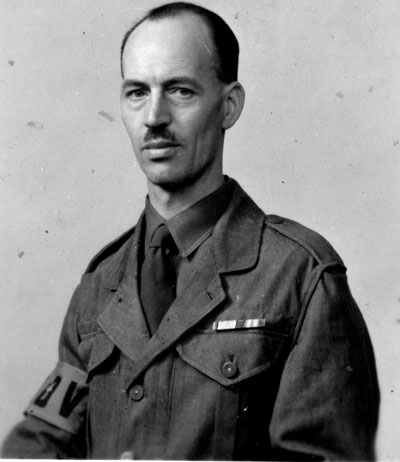 At that time,
when Home Guard commissioned ranks were first listed, the name of a
Lt. H. J. George appears: in due course Lt. George was
promoted, probably from the role of Platoon Commander, to
the rank of Major with responsibilty for an entire Company
and also the duty of acting as
second-in-command to the
Battalion C.O.
At that time,
when Home Guard commissioned ranks were first listed, the name of a
Lt. H. J. George appears: in due course Lt. George was
promoted, probably from the role of Platoon Commander, to
the rank of Major with responsibilty for an entire Company
and also the duty of acting as
second-in-command to the
Battalion C.O.
Horace Judge George (1899-1974) signed up
for the Home Guard on Wednesday, 15th May, 1940 when he
was just forty. (It would have been difficult for him to
have joined any earlier: the creation of the force
was only announced the previous evening during
the famous broadcast
by the Minister of Defence, Anthony Eden!) But as a result
of his prompt action, his span of service will always be a
remarkable "15th May 1940 - 31st December 1944".
He is seen (right)
in the earliest days of his service, bearing the LDV
brassard which was rapidly replaced by one bearing the
title "HOME GUARD" following Churchill's demand for the
change of name.
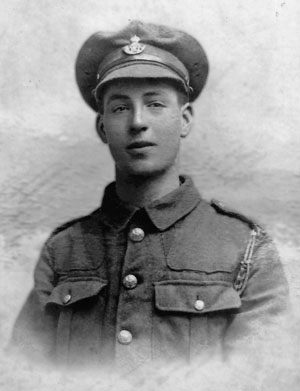
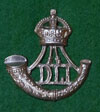 Horace George had previous military
experience, as can be seen from the ribbon he is wearing
in the above image. Having volunteered to join the Army
when he was 17 he was
eventually
called up in 1917 and was sent to France in April, 1918 as
a Private in the Durham Light
Infantry. He was therefore involved in the Spring
1918 Offensive of the German Army in its final desperate
attempt to end the war before the full effect of numerous,
fresh troops from across the Atlantic started to be felt.
On May 19th of that year he was struck by shell fragments
whilst on guard at a pithead in
Lievin, near Lens,
as a result of which his right leg had to be amputated
above the knee. He returned to England, after having spent
just 50 days in France, for treatment, recuperation and
the fitting of an artificial right leg. His injury (and
resulting repatriation) may well have saved his life; but
it also affected it for the rest of his days.
Horace George had previous military
experience, as can be seen from the ribbon he is wearing
in the above image. Having volunteered to join the Army
when he was 17 he was
eventually
called up in 1917 and was sent to France in April, 1918 as
a Private in the Durham Light
Infantry. He was therefore involved in the Spring
1918 Offensive of the German Army in its final desperate
attempt to end the war before the full effect of numerous,
fresh troops from across the Atlantic started to be felt.
On May 19th of that year he was struck by shell fragments
whilst on guard at a pithead in
Lievin, near Lens,
as a result of which his right leg had to be amputated
above the knee. He returned to England, after having spent
just 50 days in France, for treatment, recuperation and
the fitting of an artificial right leg. His injury (and
resulting repatriation) may well have saved his life; but
it also affected it for the rest of his days.
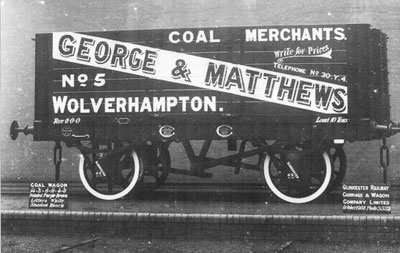
When
war broke out in September 1939, Horace George was married
and had two sons, Ben and David. At that time he was
living in Windsor Avenue, Penn
and worked within the family coal merchant and haulage and
canal carrier business,
George & Matthews (1924) Ltd.
of Van Dyke Wharf
in Bilston Road, Wolverhampton.
He would continue to work there until his retirement in
1964.
After his prompt signing up in May 1940 he was
part of a unit which rapidly evolved into the
34th Staffs
(Bilston) Battalion. Like many others in a position of
authority, his previous military experience ensured that
he was given immediate responsibility. An early role was
as a Platoon Commander. The following photograph may well
be an image of that Platoon. Lieutenant George sits amidst
his comrades, NCOs (many of them bearing a Great War
ribbon) and the other ranks who made up the remainder of
the Platoon – privates (or, more probably, "Volunteers" as
they were known in the early days of the Home Guard).
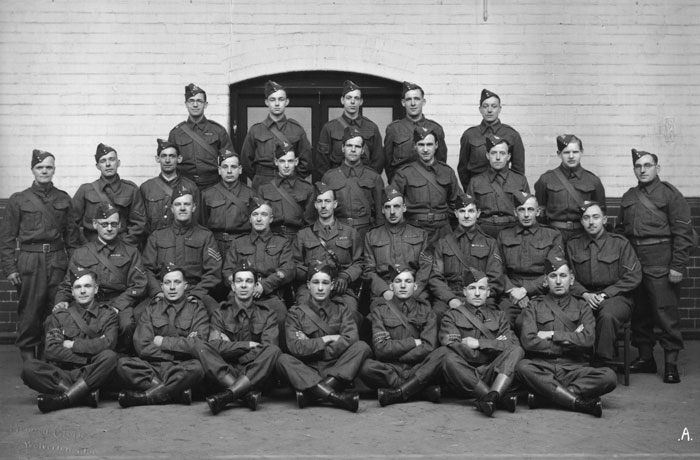
Click on image to view
higher definition version
A very similar group image survives, probably
taken at the same time and in the same place. This is of
another group of men, probably another platoon and this
one commanded by J. Pitkeathley,
later to become Battalion C.O.
Click on image to view
higher definition version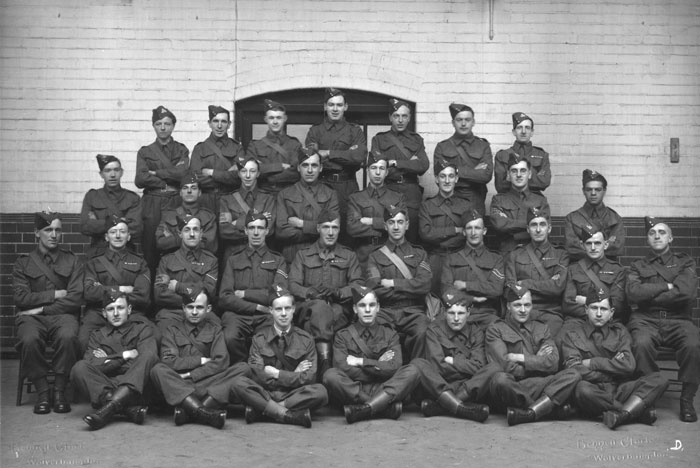
Click on image to view
higher definition version
Weeks of hard work ran into months, and the months
ran into years - intensive training, exercises, parades,
guard duty, observation. As the service
settled down to regular routines, after the first months
of desperate activity, the minimum amount of time which
any Home Guard had to devote to the service was 48 hours
per month; and many, especially those in positions of
responsibility, found themselves giving much more. All at
the same time as holding down demanding day jobs in
difficult times. Conscripts started to appear, to serve
alongside the original volunteers.
Seventy-five years later we have to rely
on fragments of information to give an idea of the scope
of this activity. Here is a minor example: a Proficiency
Certificate issued in 1943 to a private in the Battalion
and confirming the level of proficiency which he had
achieved in various activities, all gained only after hour
after hour of training provided by unit specialists and
practice by the individual.
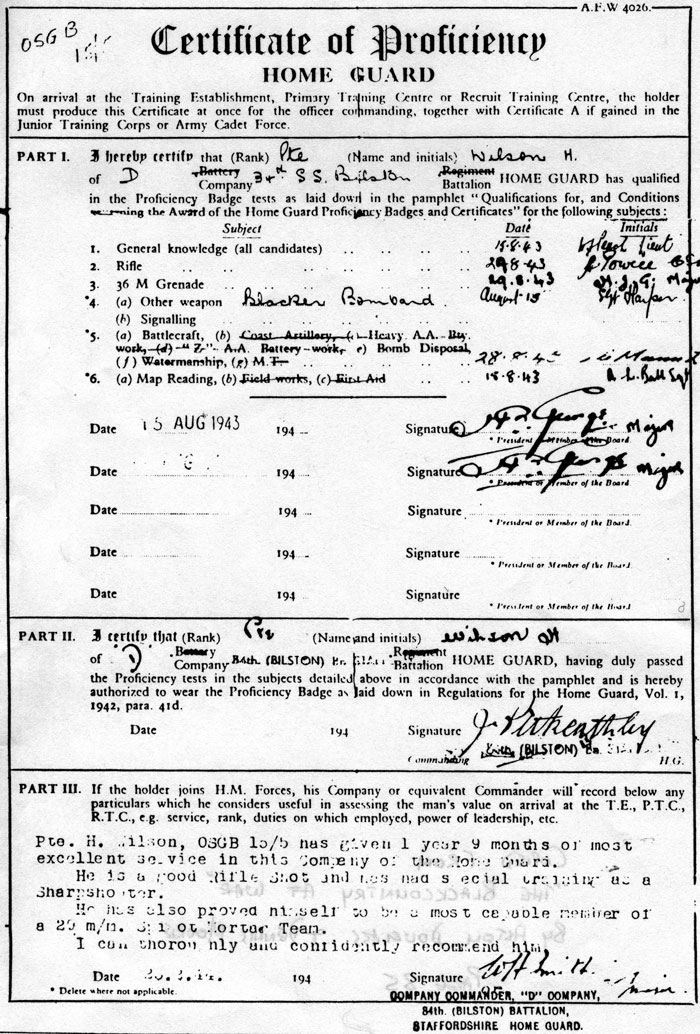
This piece of paper tells us, not only that
Pte. H. Wilson of "D" Company
(responsible for the John
Thompson works) had given almost two years of excellent service, attested
to by his Company Commander, Major
W.H. Smith, but that he was now proficient in a
number of skills essential to the effectiveness and
survival of a typical infantryman. It also tells us a
little about other Battalion members and their role. In
late August 1943, Pte. Wilson was tested for General
Knowledge by Lt. W. S. Peach;
for Rifle by C.S.M. Powell;
for 36 Mills Grenade by Major H. J.
George; for Blacker Bombard/Spigot Mortar by
Sgt. Harper; for Battlecraft
and Bomb Disposal by an unknown officer or NCO; and for
Map Reading by Sgt. A.L. Ball.
All this countersigned and approved by the Battalion
Commander, Lt.-Col. J. Pitkeathley
and his deputy and President or Member of the
Examining Board, Major H. J. George.
It is very likely that all these men appear
somewhere in the various photographs on this page; but
regrettably most so far remain largely unidentified.
| (N.B. Pte. Wilson is stated
on the above certificate to be a member of "34th
S.S. Battalion". This somewhat startling
affiliation is of course not what it sounds like.
South Staffordshire Home Guard Battalions adopted
this abbreviation during the war: the Nazi S.S.
organisation was of course known about but it was
only later, when the detail and extent of its
appalling crimes were eventually revealed, that
those initials became inextricably associated with it,
exclusively and probably for all time. Until
then, the Staffordshire Home Guard used them, in all innocence, as a
useful abbreviation). |
The role of Platoon Commander and of Company
Commander were of course energetic ones, requiring a fully
fit man to fulfil them. As we imagine and admire the
intensity of all these men's efforts, mental and physical,
over four-and-a-half long years, it is easy to forget that
Horace George suffered from a severe disability as a
result of his Great War service. But there is no evidence
that the loss of a leg in any way impaired his
performance. To the contrary, in fact - there is one
memory of how a virtue was made out of necessity and led
to recognition of his Platoon's initiative and
effectiveness:
| Once, his wife related, he came
home with his uniform completely wet; he asked her
to wash and dry it, ready for the next weekend. He
explained that his Company had been on manoeuvres,
competing with another Company in a race to cross
the canal and capture a building. The long way
would have been to go to the nearest lock to cross
the canal, but he decided that his unit should
swim the canal to get there first. "Come on, men!"
he called as he jumped in. As one of his men said
later, they weren't going to get a one-legged
b****r beat them, so all but two – who couldn't
swim – jumped in after him. Crossed the canal and
captured the building to win the day. They were
congratulated by the umpiring officer and felt
quite triumphant until they returned home to face
their wives, who were not at all pleased at the
thought of washing their dirty, wet and heavy
uniforms. |
The Old Soldier's "tell 'em nothing" principle...
| On another occasion, the Company
was being inspected by an Army bigwig, who noticed
that the major had been limping. "Hurt your leg,
George? was the question.. "Yes, sir" Horace
replied and provided no further details. Nothing
more was said.... |
In 1943...
One weekend in the summer of that
year, the Bilston Home Guard had a weekend away
"in camp" at The Bratch waterworks in Wombourne.
One of the activities was firing live "full size"
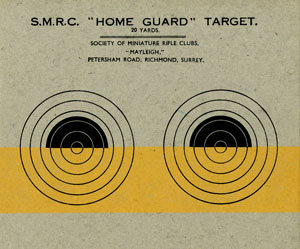 ammunition
in a quarry at Lower Penn near Wombourne which had
been adapted as a firing range. Horace's two sons,
Ben and David, had been allowed to join the camp
for the weekend and were excited at being allowed
to participate in the shooting, and to experience
for the first time just what a "kick" from a .303
rifle was like; they had only fired smaller stuff
at School where they were both members of the
Junior Training Corps. (The Home Guard also fired
small bore weapons in training, as an unused target from
those days confirms - right). ammunition
in a quarry at Lower Penn near Wombourne which had
been adapted as a firing range. Horace's two sons,
Ben and David, had been allowed to join the camp
for the weekend and were excited at being allowed
to participate in the shooting, and to experience
for the first time just what a "kick" from a .303
rifle was like; they had only fired smaller stuff
at School where they were both members of the
Junior Training Corps. (The Home Guard also fired
small bore weapons in training, as an unused target from
those days confirms - right).
It was of
course because of the boys' military training in
the JTC that they were allowed to join the camp.
Such training however had not fitted them for the
job they were given at the camp – selling
cigarettes, which their father had somehow managed
to acquire in large numbers, to their fellow
campers. |
Triumph over Adversity...
| He was allowed petrol which was
strictly rationed, to use his car for his Home
Guard duties and to get to and from work. But it
is remarkable that he was able to drive a car at
all with only one functioning leg, which had to be
used to operate the clutch, brake and accelerator.
It all required a certain amount of ingenuity. For
"hill starts" he used his hand to place the foot
of his artificial leg on the accelerator to get up
enough revs before letting in the clutch with his
left. As soon as the car was moving, though, the
right leg had to be moved back out of the way and
the good leg permitted to take over all
operations. No one really appreciated at the time
just what a feat it was for him to drive as he
did. |
We are fortunate that the family archive of Horace George and his successors still include a quantity
of images which provide further glimpses of the life of
this Battalion - no doubt typical of many, many others
but, in terms of individuals and locations, very specific
to Bilston.
These images can be viewed on associated pages:
- The Bilston
H.G. Main Page
-
Parade and Review
(Bilston Town Centre, 1943)
-
Battalion Display (Hickman Park, 1944)
**********
In memory of
Major
Horace
Judge George
and of all his comrades
in
34th Staffordshire (Bilston) Battalion,
Home Guard
and of his son
Ben George
(1927-2017)
Linguist
and Solicitor |
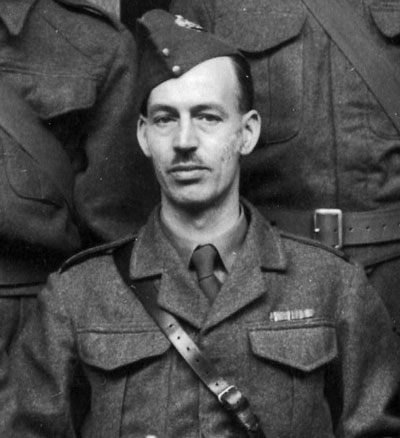 |
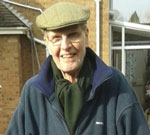
Acknowledgement
Grateful
acknowledgement is made to Pam and the late Ben George
(right)
for much of this
information about Ben's father and his comrades; and for
their generous permission
for its publication within this website.
Images © Ben George
2017
x147 - January 2017, amended April 2018